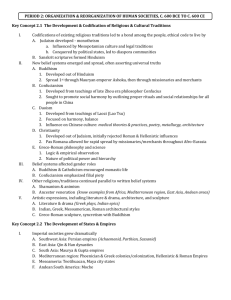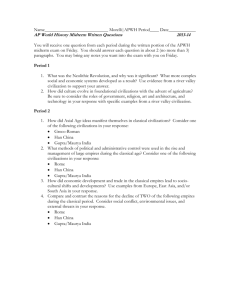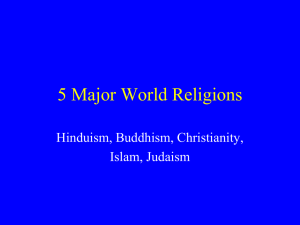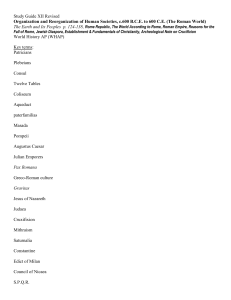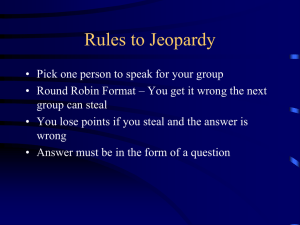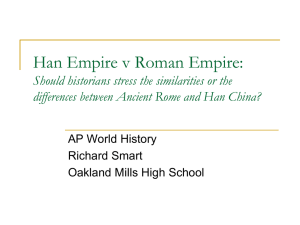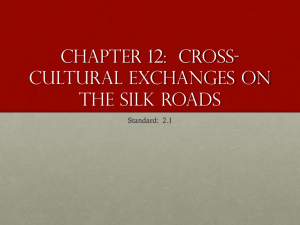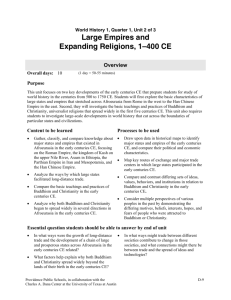South Asia
advertisement
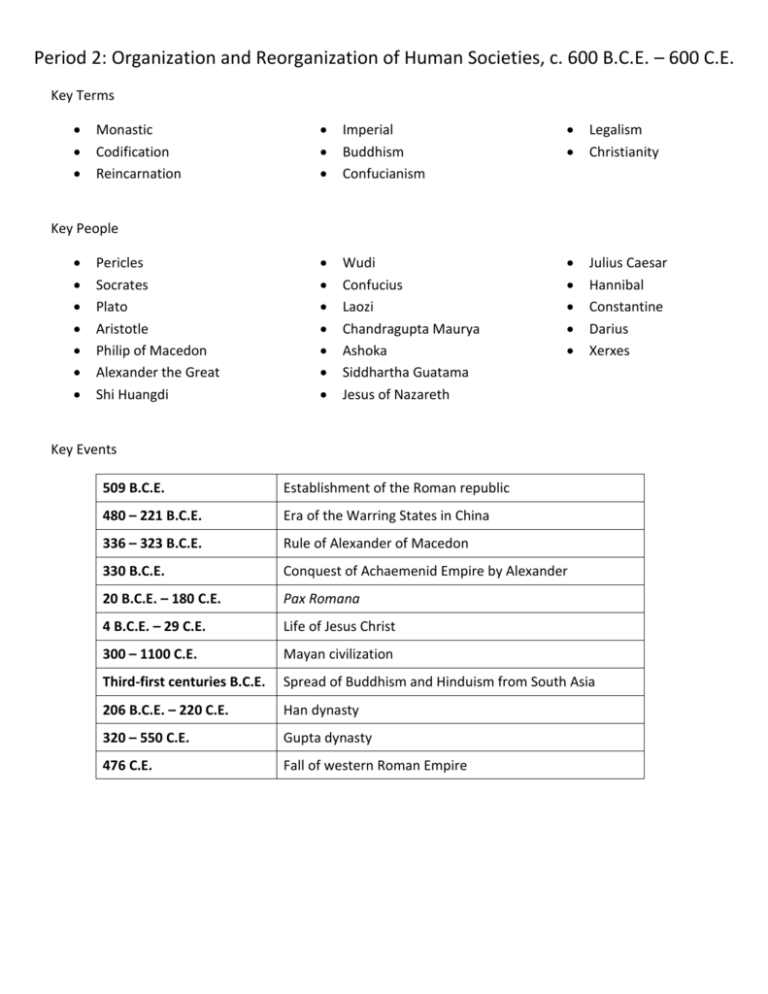
Period 2: Organization and Reorganization of Human Societies, c. 600 B.C.E. – 600 C.E. Key Terms Monastic Codification Reincarnation Imperial Buddhism Confucianism Legalism Christianity Wudi Confucius Laozi Chandragupta Maurya Ashoka Siddhartha Guatama Jesus of Nazareth Julius Caesar Hannibal Constantine Darius Xerxes Key People Pericles Socrates Plato Aristotle Philip of Macedon Alexander the Great Shi Huangdi Key Events 509 B.C.E. Establishment of the Roman republic 480 – 221 B.C.E. Era of the Warring States in China 336 – 323 B.C.E. Rule of Alexander of Macedon 330 B.C.E. Conquest of Achaemenid Empire by Alexander 20 B.C.E. – 180 C.E. Pax Romana 4 B.C.E. – 29 C.E. Life of Jesus Christ 300 – 1100 C.E. Mayan civilization Third-first centuries B.C.E. Spread of Buddhism and Hinduism from South Asia 206 B.C.E. – 220 C.E. Han dynasty 320 – 550 C.E. Gupta dynasty 476 C.E. Fall of western Roman Empire Key Comparisons 1. 2. 3. 4. 5. 6. Political, economic, and social characteristics of the empires of Rome, Han China, and Gupta India Exchanges in the India Ocean versus those in the Mediterranean Sea The expansion and appeal of Buddhism, Hinduism, and Christianity The origins, philosophies, and goals of Confucianism and Daoism The decline and fall of Han China, Rome and Gupta India Trans-Saharan versus Silk Roads trade Key Concepts 1. The Development and Codification of Religious and Cultural Traditions a. Codification of scripture i. Jewish scripture 1. Further developed existing scripture 2. Influenced by Mesopotamian cultural and legal traditions a. Assyrian, Babylonian and Roman empires conquered the Jewish states i. Led to the development of the Jewish diaspora ii. Sanskrit scripture formed the Vedic religions 1. Led to the development of the caste system b. New belief systems emerged i. Buddhism 1. Response to some of the Vedic beliefs 2. Changed over time a. Support of Mauryan Emperor Asoka b. Missionaries and merchants c. Educational institutions ii. Confucianism 1. Based on the teachings of Confucius a. Analects 2. Promote social harmony a. Through proper rituals and social relationships iii. Daoism 1. Based on the teachings of Laozi a. Daodejing 2. Balance between humans and nature 3. Influenced medical theories and practices, poetry metallurgy or architecture iv. Christianity 1. Based on the teachings of Jesus of Nazareth a. Recorded by his disciples – Bible 2. Drew on the monotheism of Judaism 3. Spread through the efforts of missionaries and merchants 4. Originally met with hostility by Roman and Hellenistic societies 5. Gained imperial support under Emperor Constantine v. Greco-Roman philosophy 1. Emphasized logic, empirical observation and the nature of political power and hierarchy vi. Belief systems effected gender roles 1. Buddhism and Christianity encouraged monastic life 2. Confucianism emphasized filial piety vii. Other belief systems continued 1. Shamanism and animism 2. a. Daily reliance on the natural world b. Shaped lives within and outside core civilizations 2. Ancestor veneration a. Africa b. The Mediterranean c. East Asia d. Andean areas 3. Art showed cultural development a. Literature and drama i. Greek tragedy ii. Indian Epic iii. Would influence later cultures b. Distinctive architectural style developed c. Greco-Roman culture and Buddhist beliefs converged to develop and new sculptural style i. Syncretism The Development of States and Empires a. Many imperial societies developed i. Southwest Asia: Persian Empires (Achaemenid, Parthian, or Sassanid) ii. East Asia: Qin and Han dynasties iii. South Asia: Maurya and Gupta Empires iv. Mediterranean Region: Phoenicia and its colonies, Greek city-states and colonies, and Hellenistic and Roman Empires v. Mesoamerica: Teotihuacan, Maya city-states vi. Andean South America: Moche b. New styles of imperial administration developed i. Governments created institutions to organize subjects (China, Persia, Rome and South Asia) 1. Centralized government 2. Legal systems 3. Bureaucracies ii. Empires projected military power over surrounding areas using many techniques 1. Diplomacy 2. Supply lines 3. Fortifications 4. Defensive walls and roads 5. Adding officers and troops from the local populations iii. Trade played a key role the success of empires 1. Built and maintained roads 2. Issued currency iv. Social and economic 1. Cities were centers of trade, religious rituals, and political administration a. Persepolis b. Chang’an c. Pataliputra d. Athens e. Carthage f. Rome g. Alexandria h. Constantinople i. Teotihuacan v. Decline of Empires 1. Roman, Han, Persian, Mauryan, and Gupta 2. Internal Causes a. Excessive mobilization of resources b. Environmental damage i. Deforestation ii. Desertification iii. Soil Erosion iv. Silted Rivers c. Social tension d. Economic difficulty i. Too much wealth in the hands in the elite 3. External causes a. Security issues along the frontier i. Threat of invasion ii. Han China and the Xiongu iii. Gupta and the White Huns iv. Romans and their northern and eastern neighbors 3. Emergence of Transregional Networks of Communication and Exchange a. Transregional networks of communication and exchange developed i. Eurasian Silk Roads ii. Trans-Saharan caravan routes iii. Indian Ocean sea lanes iv. Mediterranean sea lanes b. New technologies helped the trade i. Domestic pack animals could transport goods across longer distances 1. Yokes 2. Saddles 3. Stirrups ii. Innovations in maritime technology 1. Lateen sails 2. Dhow ships 3. Knowledge of monsoon winds c. Goods and ideas spread along the trade routes i. Crops 1. Rice and cotton from South Asia to the Middle East a. New farming and irrigation techniques i. Qanat system ii. Diseases 1. Diminished urban populations 2. Contributed to the decline of some empires (Rome and Han China) iii. Religious and cultural traditions 1. Religions were transformed as they spread a. Chinese culture b. Christianity c. Hinduism d. Buddhism Region East Asia S. E. Asia Oceania Central Asia Political Economic Social Changes Continuities Dynastic rule Mandate of Heaven Centralized government Great Wall Civil service exam Rice, millet Bronze crafts Ironworking Silk production Silk Road trade Paper Urbanization Patriarchal societies Stratified society Confucianism Daoism Development of philosophy Chinese traditions of Confucianism, family Dynastic rule Ancestor veneration Mandate of Heaven Chinese influence Root crops Fruit Trade with South Asia Urbanization Hinduism Buddhism Adaptions of Chinese culture Hinduism and Buddhism Urbanization Agriculture Regional kingdoms Foraging Polytheism Animism Tribal organization Development of kingdoms Foraging Austronesian migrations Tribal governments Chinese influence Migrations toward classical empires Nomadism Trade facilitators Indo-European migrations Trade facilitators Invasion of classical empires Pastoral nomadism Shamanism Hinduism Buddhism Caste system Dynasties Agriculture Interest in technological advancement Active trade Vedas Sanskrit Development of major religions Agriculture Irrigation Trade Judaism Zoroastrianism Long-distance trade Decline of Egyptian civilization Christianity Regional kingdoms Village life along the Nile Urbanization Patriarchal societies Hinduism Varna Buddhism Inoculation Sati Urbanization Polytheism Stratified society Slavery Judaism Zoroastrianism Christianity Urbanization Village life on the Nile Pyramids Hieroglyphics Polytheism Stratified society Christianity Community planning Mauryan and Gupta dynasties Grains Indian Ocean trade Persian Empire Hellenistic Empire Grains Wheel Cuneiform Trade with Indus Valley and Egypt Camel saddle Pharaohs Kingdoms of Kush, Axum and Ethiopia Barley Trade with Sumer and Persia Ironworking Salt/palm oil Use of Camel saddle Trade with Rome Regional kingdoms Root crops Trans-Saharan trade Ivory trade/Indian Ocean Polytheism Animism Indian Ocean trade Sub-Saharan trade Regional kingdoms Polytheism Ancestor veneration Bantu migrations Athenian democracy Poleis Hellenistic Empire Roman Empire Greek trade/colonization Silk Roads trade Roman roads Decline of trade and learning Phoenician alphabet Olympic games Greek drama Greek philosophy Hellenistic thought Pax Romana Roman law Christianity Fall of Roman Empire Greco-Roman culture Eastern Europe Byzantine Empire Justinian’s attempts to recover Roman territory Code of Justinian Agriculture Center of trade Greek learning Christianity Urbanization and trade in Byzantium Greco-Roman culture North America Tribal government Regional empires Maize Nomadism Some trade with Mesoamerica Trade expansion Village life Nomadism Polytheism Shamanism Latin America City-states Mayan civilization Andean societies and civilization Maize, potato Llama, alpaca Obsidian, jade Limited trade Pyramids Ceremonial buildings Mayan astronomy Mesoamerican traditions Shamanism Ancestor veneration South Asia S.W. Asia North Africa SubSaharan Africa Western Europe Village organization Polytheism Urbanization Quetzalcoatl Stratified society Zero Astronomy Calendar
